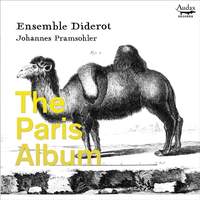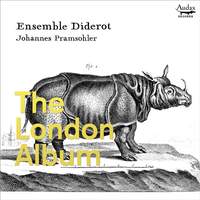Interview,
Johannes Pramsohler on early trio sonatas
 Johannes Pramsohler's early music ensemble Ensemble Diderot has made a speciality of exploring chamber repertoire from the Baroque period; normally releasing roughly one album a year, this year they have served up a double helping with the Paris Album and the London Album, exploring two distinct national styles of chamber composition at a moment of transition, with fashionable ideas from Italy spreading over the Alps and Channel and influencing tastes and music-making in France and England.
Johannes Pramsohler's early music ensemble Ensemble Diderot has made a speciality of exploring chamber repertoire from the Baroque period; normally releasing roughly one album a year, this year they have served up a double helping with the Paris Album and the London Album, exploring two distinct national styles of chamber composition at a moment of transition, with fashionable ideas from Italy spreading over the Alps and Channel and influencing tastes and music-making in France and England.
I spoke to Johannes about this pair of albums, and the musical landscape of which they each present a unique snapshot.
These two albums, shining the spotlight on two different musical traditions each in a state of flux, have come out simultaneously. Is this an intentional juxtaposition of them as two sides of a coin, or was it just chance that this is how things turned out?
It was intentional, since the trio sonata happened to arrive at about the same time in both countries. I wanted to show how each country dealt in its own manner with the new style and form that originated in Italy. England and France were connected in several ways; Charles II and Louis XIV were cousins and both were music aficionados. Both countries had gone through deeply affecting events: England had just restored the monarchy, and France was at the end of its tether due to numerous wars.
It is fascinating to see how the English composers managed to merge the sonata style with the tradition of counterpoint that we know from English consort music. The French composers, on the other hand, gave their sonatas a much lighter touch by inserting dance elements and overture-style dotted rhythms. The outcome in both cases is highly interesting, entertaining and deeply moving music.
The Paris Album features a sonata by Elisabeth Jacquet de la Guerre, almost the only female composer between Hildegard of Bingen and Clara Schumann to achieve any enduring fame or success on a playing-field that was far from level. How do you think de la Guerre managed to make it where numerous others must have tried and failed?
De la Guerre was a woman from a very privileged background. She was born into a family of musicians and instrument-makers and grew up surrounded by music. Her father taught her, and she was introduced to the court at a very young age. She married an organist and therefore spent her whole life in a musical environment. Her personal circumstances made it possible for her to succeed. Maybe there is actually a parallel to be drawn to today: I think we still need to work a lot more on creating an environment where women actually see a chance to succeed in the top positions.
It’s always impressive when a world premiere is presented of a work from several centuries ago, and there are several on each of these albums. How did you come across these previously-unknown works?
The two sonatas by Campra and those by Brossard were in my library already before I founded the Ensemble Diderot. Actually, the whole “Paris” programme was ready more than ten years ago, and we have often performed parts of it in concerts. The English world premieres I came across during the research for my PhD at the Royal Academy of Music, which I am about to complete. I undertook countless trips to libraries and studied catalogues and doctoral thesis of other musicologists in order to get a complete overview of the trio sonata in seventeenth-century England.
The common ground between the two albums is that they present the national styles of France and England at the cusp of the “Italian invasion”, the large-scale adoption of Italian tastes and fashions by composers throughout Europe. Why do you think it was Italy, rather than some other nation, that ended up exporting its musical style in this period?
Because music as we know it today was born there! Everything emerged from Italy. It started after the Middle Ages with the first Renaissance artists like Dante and Giotto. And during the Counter-Reformation it was also Italy which “invented” the new baroque style in order to bring people back into the fold. It happened throughout all the arts, including music. The style also perfectly suited the desire of Europe’s absolutist rulers for pompous representation, and so it spread and even became the first global style.
You comment in the notes to The London Album (perhaps pointedly in view of ongoing political dramas) on the tendency of the English towards openness and the embracing of foreign influences. Do you think this trait is specific to England, and do you still see it today?
I do think it is a specific English trait to be welcoming and open-hearted. At least that’s what I’ve always experienced. I was welcomed with open arms when I arrived in London to study music, and the unique way of professional music-making at the highest level always impressed and inspired me.
Does the choice of a camel to adorn the cover of The Paris Album, and of a rhinoceros for The London Album (and indeed a zebra for your Dresden-focused release of a few years ago), have any particular significance?
Not really. It was the choice of our incredibly talented graphic designer Christian Möhring, who designs all our albums. He is based in London, and I love his ideas. Together we decided to use engravings from Diderot’s Encyclopedia; I thought of course of musical instruments or landscapes, but then he came up with a zebra for our first album and I immediately fell in love with it, so we decided to have a different animal for each of our city-themed albums. Watch this space for more!
Ensemble Diderot, Johannes Pramsohler
Available Formats: CD, MP3, FLAC, Hi-Res FLAC
Ensemble Diderot, Johannes Pramsohler
Available Formats: CD, MP3, FLAC, Hi-Res FLAC
Ensemble Diderot, Johannes Pramsohler
Available Formats: CD, MP3, FLAC, Hi-Res FLAC





